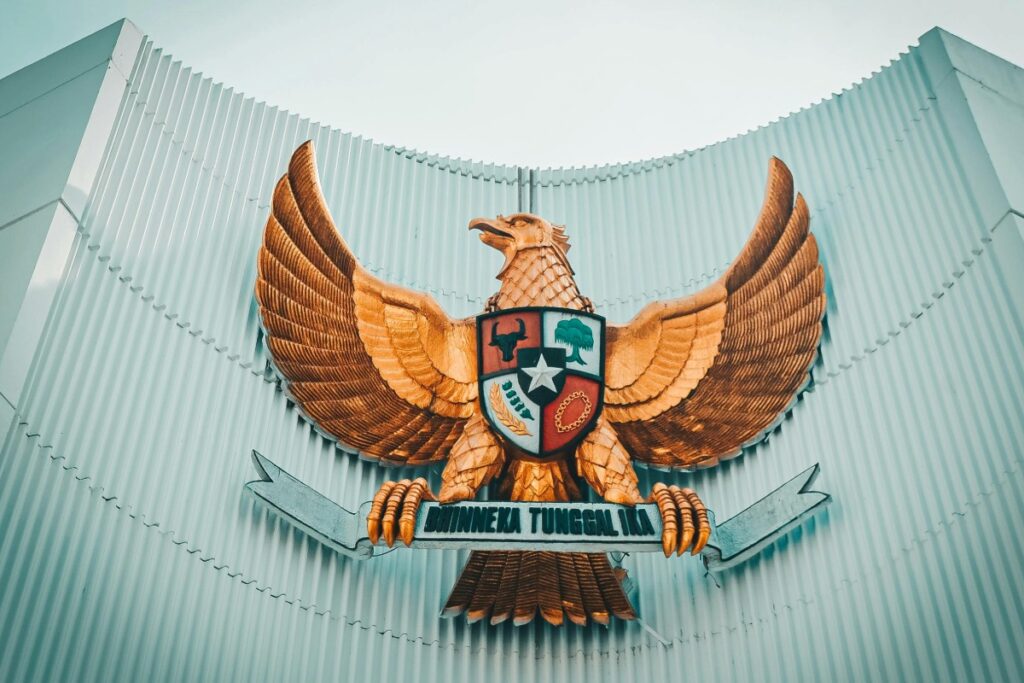Garuda is one of Indonesia’s most enduring symbols — a figure of courage and loyalty that has shaped stories, art, and even the nation’s identity. This half-human, half-bird guardian has long been a cornerstone of heritage, so much so that the nation’s airline carries his name, Garuda Indonesia.
In this guide, we explore the origins, symbolism, and lasting influence of Garuda in Indonesian culture.
Table of Contents
ToggleOrigins of Garuda in Hindu Mythology
Garuda’s story traces back to the great Hindu epics — the Mahabharata, the Puranas, and the Ramayana — where he appears as a divine bird fighting for justice and freedom. In these legends, he is brave and selfless, battling evil tirelessly. One Ramayana tale even sees him face Rahwana, the demon king who kidnapped Sita. Though Garuda falls, his sacrifice embodies resistance and devotion — values that later inspired Indonesia to adopt him as a national emblem.
Garuda in Indonesia: From Epic to Emblem
In the Adiparwa, Garuda is born of Dewi Winata and the sage Kasyapa. When his mother was enslaved by Dewi Kadru and her thousand snakes, Garuda vowed to set her free. His quest for Amerta, the water of life, led him into battle with gods and demons until Vishnu himself intervened.
Impressed by his courage, Vishnu granted him Amerta and, in return, Garuda became his eternal vahana, or mount. This story embodies loyalty, sacrifice, and the fight for justice — qualities that live on in the Garuda Pancasila and in the pride carried by Garuda Indonesia, the nation’s flag carrier.
Garuda in Balinese Culture
In Bali, Garuda is not only a mythic figure but a sacred presence — carved in temples, painted on offerings, and towering in the Garuda Wisnu Kencana statue. He embodies courage, devotion, and spiritual protection, qualities that remain woven into daily rituals and ceremonies.
The story of Garuda and Naga, where he battles the serpents to free his mother, remains one of Bali’s most powerful legends, symbolising freedom from oppression. His image is everywhere: in wood carvings, temple sculptures, and ceremonial objects. The most awe-inspiring tribute is the Garuda Wisnu Kencana statue in Ungasan — a monument to cultural pride, spiritual depth, and artistic mastery.
Cultural Meaning and Modern Significance
Garuda carries many layers of meaning: king of the skies, son devoted to his mother, symbol of freedom and resilience. Over centuries, his spirit moved from story to state, shaping Indonesia’s identity. Today, Garuda lives on in the national emblem, Garuda Pancasila — a Javanese eagle with wings and feathers coded to Independence Day (17.8.1945), a shield representing Pancasila, and talons holding the national motto, Bhinneka Tunggal Ika (Unity in Diversity).
Fun Facts & Trivia
Garuda and Naga – Eternal Rivals
In myth, Dewi Winata (Garuda’s mother) was tricked by her sister Dewi Kadru, the mother of a thousand snakes. Since then, Garuda and Naga have been eternal rivals, symbolising the struggle between sky and underworld.
Head Turned Right
On the Garuda Pancasila, the head always turns right — the side of truth and virtue.
Garuda-Inspired Palace
Garuda’s story continues to shape Indonesia — from sacred legend to national symbol — reminding us of strength, loyalty, and sacrifice. In Bali, he remains a guardian carved in stone and remembered in ceremony, a timeless reminder of the values that carry through generations.
And just as Garuda stands watch in myth and monument, places like Tanah Lot Temple carry that same spirit of guardianship and devotion — living symbols where culture, nature, and faith still meet.






